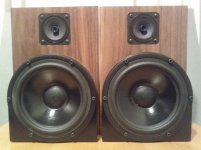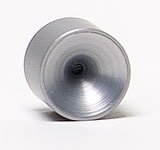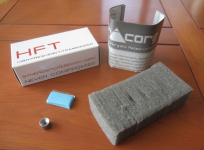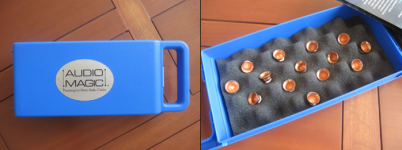Makes no sense if it's balanced though... unless you mix them up half and half.
I also have a dual channel Anritsu, if you like. Not needed to find the beginning of skin effect.
-RNM
Belden's comments.
Understanding Skin Effect and Frequency
It appears skin effect begins at about 8Khz (red).
View attachment 564997
THx-RNMarsh
I understand and actually often have to cater for skin effect but not at Audio frequencies and power and from everything I have read and heard skin effect at audio frequencies is not audible, so my why was more specific, is their new research regarding skin effect at audio frequencies.
The article while mentioning audio frequencies is more about video frequencies and long runs, not a metre or so interconnect in an audio system.
jneutron, is skinning relevant for 50 / 60 Hz power distribution? One teacher told me so.
Can do for power distribution, buss bars have already been mentioned... flat conductors broadside coupled.
As well as skin effect their is also proximity effect, that we discussed a couple of years ago on here, this can further compound the problem as current density is increased in certain areas of the conductor, will try and find the link I posted that showed it.
It's like having Frank back again.😀
What happened to Frank (seriously)?
We now only have one antipodian making outrageous claims.
😀
That's a matter of opinion.
Guess we're operating in a different realm. 🙁
_-_-bear
We are. In mine, verified facts are preferred 😎.
The Yamaha NS10 Story | Sound On Sound
Last edited:
BS. Go here The Secret Society of Lathe Trolls • View topic - 100% analog and start about the 12th post down.
" by TotalSonic » Mon Jul 25, 2011 12:49 pm
100% analog can be done in a couple different ways - either with fixed or manual pitch so that only a single signal path from the analog source is needed - or via a preview tape deck with an initial "preview" playback head going to the pitch/depth computer, followed by extra capstans allowing the tape path to be extended an appropriate amount for a delay, and then a "program" playback head sending the signal to the cutter head. Preview decks were made by Telefunken, Studer, and Sony/MCI (such as my JH110M - photo below), and I've seen some mod Ampex ATR decks as well.
As far as studios equipped with preview decks that can do all analog mastering in the USA there is:
Salt Mastering - Mastering for CD and Vinyl - Brooklyn, NY
Masterdisk - Your music deserves the best.
STERLING SOUND - Audio Mastering Studio - New York City
The Mastering Lab | closing - The Mastering Lab
...and possibly a few more I've forgotten in that list as well. "
I correct my statement 'MOST AAA vinyl has gone through a digital delay line'. Note equipped does not mean use!
What is curious is that this fact is not lauded on the sleeve, nor in the gushing reviews from the comedian. Nor is there any secret list of true analog out there. You would have thought that people who sold vinyl accessories would put lists like that on their websites?
Tellingly on the sterling sound site here Vinyl - STERLING SOUND they say that analog preview is preferred, but not how often they use it, if at all. Anyone would think they were trying to confuse the issue. Still good to know some are still doing it the old skool way.
So I went to Amazon to try to figger out what is this 'redbird' of which you all speak.
About a dozen hits on a music search there. But on one of them, I noticed a review moaning about that CD not having had proper studio mixing/mastering technique applied. Then noticed a comment about that review by one Stuart Yaniger. Guess that's the album!
(ordered a copy, thanks)
My bad I searched 'redbird cd' and it was the first hit but didn't think to try just redbird. Sorry.
I am most interested to hear your A system one day, I have heard one of your JC amps and it unsighted impressed me favorably from the next room.
I get your point of 'pretty good' is good enough most of the time, and same for me.
Poe has confounded me here.
I noticed a review moaning about that CD not having had proper studio mixing/mastering technique applied.
Yes, that's its strong point. 😀 It's a pity that they seem to have retired the project (they were playing together twice a year before, one set at Club Passim in Boston, one at Cafe Carpe in Ft Atkinson, WI). LMK what you think after you get it.



That blue tweeter thingy sure looks similar to the HFT thingys.

This is a scam......industrial hydraulic hose/fittings end caps in a nice box -
Audio Magic room correction bells ($600 for the set)
Dan.
Last edited:
I correct my statement 'MOST AAA vinyl has gone through a digital delay line'. Note equipped does not mean use!
What is curious is that this fact is not lauded on the sleeve, nor in the gushing reviews from the comedian. Nor is there any secret list of true analog out there. You would have thought that people who sold vinyl accessories would put lists like that on their websites?
Tellingly on the sterling sound site here Vinyl - STERLING SOUND they say that analog preview is preferred, but not how often they use it, if at all. Anyone would think they were trying to confuse the issue. Still good to know some are still doing it the old skool way.
I visited The Record Industry in Haarlem, The Netherlands, one of the largest pressing plants still existing, as part of an AES tour.
They still had the analog tape machine with the pre-listen head for gain riding as they called it.
But they confessed that, unless specifically requested y the artist(s) they used digital masters with digital pre-listen.
They also said that there still are some artists that insist on full analog processing and even submit their files on an analog tape, but it is an infinitesimal small fraction of the total
Jan
stellar print Lp , folk singer Muddy Waters, Chess lps-1433 print by Classic records
1963 el Mar Recording Studios, Chicago
UA tube mixer console.
Ampex 350/1 tapemachines.
Echochamber.
1963 el Mar Recording Studios, Chicago
UA tube mixer console.
Ampex 350/1 tapemachines.
Echochamber.
Last edited:
We have already discussed that paper and pointed out the flaws in it; the author was talking nonsense for much of it. The red part of the graph has nothing to do with skin effect; it is the point where inductance begins to take over from resistance, so the wire begins to act more like a (very short) transmission line.RNMarsh said:It appears skin effect begins at about 8Khz (red).
Test them for what? Measuring the characteristic impedance of a very short line is not easy, even for someone who knows what he is doing.OK.... I am dragging out my Network/Z analyzers and will test a variety of cables myself and see. I have to find my high Z probe and CT, too.
I don't quite understand the apparent dichotomy you appear to see between physics and electricity.I dont doubt your physics on the subject. I need electrical models, though.
The theory of transmission lines is very electrical i.e. it is based on correct physics. If you wanted to you could even derive for yourself the expression for characteristic impedance based on distributed parameters; it is just circuit theory. Then you might understand it better and realise that you don't actually need to measure it.
Yes, it would have had quite low resistance. Its characteristic impedance might have been somewhere near 7.5 ohms from about 50kHz upwards; irrelevant for audio.years ago I used 75 ohm coax - 10 cables in parallel - for a speaker cable. Worked very well.
Possibilities with digital recordings are enormous. Can a vinyl be mastered/cut so that it mimics linear tracking tonearm ? For example vinyl has 2 degrees lateral tracking error so can the recording be digitally manipulated to nullify this error ?
Thanks and regards.
addition : considering most of modern recordings are digital.
Thanks and regards.
addition : considering most of modern recordings are digital.
Last edited:
<snip> and I was going off that assumption, which would mean the gap between X and Y would be tens of minutes to hours. Either I missed you writing that detail, or that's new information forthcoming.
It was just a short abbreviated description, so why don´t you simply ask instead of assuming?
First of all, i gave a description of listening test and its results, if _you_ question these results because of an assumed limitation of human memory _you_ should be able to provide citations of relevant publications.Backwards: don't you need to claim that memory, via whatever model you choose is, in fact, still robust with your test? 70-90s is well past the usual test gap length,.....
As said before, i have read hundreds of publications about memory processes/experiments in general and more specificially related to auditory memory, but up to now i havn´t read any publication that examined the relationship between the degree of a difference (in multidimensional perception) and the ability to store it in long term memory.
Bonsai reported a couple of months ago that his wife knew about such publications but were not willing to cite some (due to time restrictions or other reasons) which in fact isn´t more helpful than the wife in the kitchen detecting all differences 🙂 (just kidding)
Secondly, it depends on the hypothesis that is tested. We were mainly interested in things that could enhance the reproduction chain and would provide more listening pleasure. A difference that we were not able to store would be of limited practical relevance as we would have forgotten already when listening to music the next day.
Otoh, if the system after the change does indeed provides better listening experience, then it is, due to the nature of the multidimensional perception and emotional reaction, much more likely to assume that storage in long term memory is possible, because of all the information we have about the way our memory works (or seem to work, as it is all about modelling and there are still a lot of questions to answer).
......and how much does the visual/tactical stimulus of the cap change procedure affect your results? Can you characterize that? How about the biases of non-blinding?
What "non-blinding"? It was a controlled listening test (single-blind); one person did the operation (cap work and music play) while the other listened.
My world is built up on: PLOS Medicine: Why Most Published Research Findings Are False
What effect does having a small N and a small difference between the two test arms (electrically speaking) have on the plausibility of your test?
Ioannidis did good work, but you have to evaluate carefully if everything is applicable to our field. Wrt to small sample sizes Ioannidis was concerned mainly of small statistical power which leads to high probability of beta-errors (means retaining the null hypothesis although it is wrong).
If a small N test finds a difference (means the null hypothesis was rejected) then it doesn´t matter anymore that it might have been underpowered in the beginning.
The next interesting question is what size of a difference has to be qualified as "small" or "medium" or "big" . To compare different research approaches you have to find a way to standardize the differences and that is often quite easy if you relate it to the measured outcome of a test. To find such relationships before, as you obviously tried, based on measured differences between two caps isn´t as simple.
To illustrate that; based on our test result, the sample estimate for the "real p" would be p = 1 (huge difference compared to the H0: p=0.5) the 95% confidence interval instead spans from (0.549 - 1) .
Perceptionwise the difference was quite large and therefore (just a couple of days after reading Shanefield´s articles) i thought let´s give it a try (thinking that it can´t be that difficult to detect under test conditions, an assumption that didn´t hold true) .
And that's before we get to the fact that the test itself is poorly conducted and reliant on increasingly long(er) term memory function. I'm not saying there's *no* difference in sound between said capacitors, just that the test you described isn't going to tell us one way or the other.
So it was poorly conducted, because of ....what?
Again, you should be able to provide some citations wrt to the inability of long term storage.
I would not conclude too much (or expands its importance) wrt to the underlying population, but it was interesting because it creates insights. Of course it was just the start and that left room for improvements.
Btw, if you really rely on Ioannidis you should question most of the evidence against audibility. Nearly every point he mentioned was applicable; thresholds of hearing were mainly reseached in small sized groups (the only large scale study i know about was done by Licklider in the fifties with ~28000 participants), the usual ABX published were mainly done by people with strong biases against audibility, more modern large scale listening test with audio codecs revealed differences afterwards that were not detected within the tests, replication of studies is quite rare and...and...and ..
I don't remember that list of arguments, but as to the latter: pot, please meet kettle. Evidence has not been forthcoming. Usually the one asserting conclusions from a test is the one who was to prove his findings.
You even responded to it http://www.diyaudio.com/forums/loun...ch-preamplifier-part-ii-8555.html#post4791404
Can you understand why I'm digging in my heels when this is the thrust of the paper?
We did an A/B-test and apparently you´ve forgotten your assertions:
"......that a triangle (I'm right here admitting that I thought those required forced choice and prior knowledge that there were 2 identical samples) and tetrad protocols are much, much, MUCH more powerful than binary tests."
"Did I not state that triangle/tetrad protocols enjoy greater statistical power?"
And as already pointed out in detail http://www.diyaudio.com/forums/loun...ch-preamplifier-part-ii-8650.html#post4800146
the paper does not confirm what you believe.
Tetrad enjoys greater statistical power than triangle, but A/B (2-AFC or 2 AC) enjoys much,much MUCH ( 🙂 ) larger statistical power than even tetrad.
What am I supposed to admit I'm wrong about, at least within this specific scope? (We needn't go down that road...)
I hope that your question is answered by now.
Last edited:
Some people hear better than other people, Marce.
What the hell is that suppose to mean, you have no idea of my hearing (actually very good for a 55 year old, last test I was told it was still like someone in their 30's). Why come out with this irrelevant rubbish instead of answering directly to what I posted regarding skin effect.
Respect works both ways you know and dissing someone's abilities without knowing what they are is disrespectful, but what I have come to expect from you John after so many years of disagreement...
Now your fan club can crawl out of what ever hole they reside in and give me more grief...
😉🙂
View attachment 565072
View attachment 565073
View attachment 565074
That blue tweeter thingy sure looks similar to the HFT thingys.
View attachment 565078
This is a scam......industrial hydraulic hose/fittings end caps in a nice box -
Audio Magic room correction bells ($600 for the set)
Dan.
Please say you don't use and promote Synergistic researches HFT, and even bigger scam...
We have been discussing skin effect over the last few years on this thread alone, is it audible, all the science sais NO, audiophiles say otherwise...
- Status
- Not open for further replies.
- Home
- Member Areas
- The Lounge
- John Curl's Blowtorch preamplifier part II